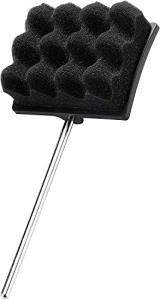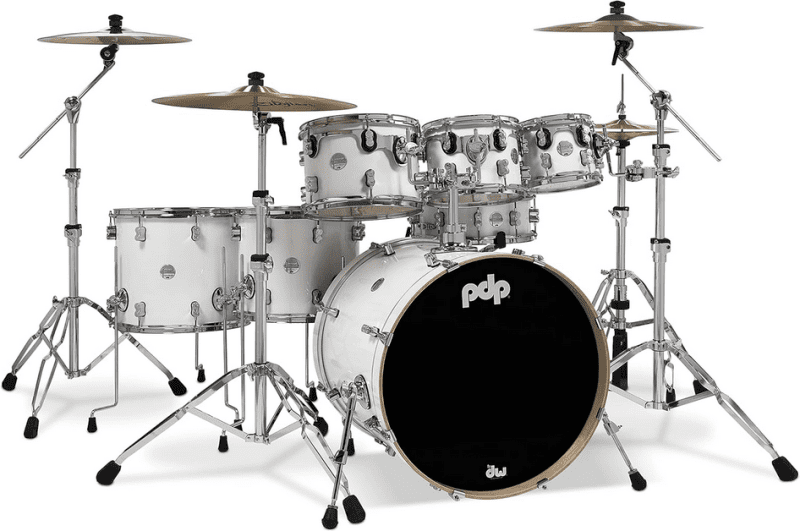As a drummer, I understand the thrill of playing along to your favorite tunes. Still, I've also experienced the frustration of disturbing others and the discomfort of being in a noisy environment. Drums are one of the loudest instruments, making soundproofing a drum room necessary for maintaining harmony with neighbors and protecting one's hearing.
Finding an affordable solution can be challenging, but there are effective drum room soundproofing tips that won't break the bank. In this article, we'll explore affordable soundproofing methods to help you create a quiet practice space.

Key Takeaways
- Simple DIY solutions for soundproofing
- Effective materials for reducing drum noise
- Budget-friendly options for soundproofing
- Tips for minimizing echo in your drum room
- Affordable ways to soundproof your drum room
Understanding the Basics of Drum Room Acoustics
To achieve optimal sound, it's essential to grasp the basics of drum room acoustics. Drum room acoustics involve understanding how sound behaves within a given space. This knowledge is crucial for both soundproofing and acoustic treatment.
The Difference Between Soundproofing and Acoustic Treatment
Soundproofing involves stopping sound transmission across walls, floors, and ceilings, while acoustic treatment reduces direct reflections and improves sound quality within the room. Soundproofing is about containing the sound, whereas acoustic treatment is about enhancing the sound within the room.
Common Sound Issues in Drum Rooms
Drum rooms often suffer from echo, reverberation, and sound leakage. A combination of soundproofing and acoustic treatment can address these issues. Echo and reverberation can make the drumming sound muddy or unrefined.
Setting Realistic Expectations for Budget Soundproofing
When working with a limited budget, it's crucial to prioritize soundproofing efforts. Focus on the most critical areas where sound leakage occurs. Even simple, cost-effective measures can significantly improve the overall sound quality.
Assessing Your Drum Room's Needs
Before soundproofing your drum room, it's essential to assess its current state and identify areas for improvement. This step is crucial for effective soundproofing.
Identifying Problem Areas and Sound Leakage Points
To soundproof your drum room effectively, you must identify where sound leaks or is produced. Common problem areas include windows, doors, and wall vibrations.
Windows and Doors
Windows and doors are typical weak points in a room's soundproofing. Check for gaps around these areas and consider how sound escapes through them.
Wall Vibrations
Wall vibrations can significantly contribute to sound leakage. Inspect your walls for any signs of vibration when playing the drums.
Simple Tests to Determine Your Room's Acoustic Properties
Simple tests, such as clapping or using a sound level meter, can help you understand your room's acoustic properties. These tests can reveal how sound behaves in your drum room.
Prioritizing Your Soundproofing Efforts
Once you've identified problem areas and understood your room's acoustic properties, prioritize your soundproofing efforts. Focus on the areas that will make the most significant difference.
| Area | Sound Leakage Impact | Priority |
|---|---|---|
| Windows | High | High |
| Doors | High | High |
| Wall Vibrations | Medium | Medium |
Top Ways to Soundproof Your Drum Room Without Breaking the Bank
Creating a soundproof drum room doesn't have to break the bank; several affordable solutions can help minimize noise leakage. By utilizing the right materials and techniques, drummers can significantly reduce the noise emanating from their practice space.
Budget-Friendly Materials That Work
Several budget-friendly materials can effectively soundproof a drum room. These include:
- Moving blankets and quilts, which can be used to cover walls and ceilings to absorb sound.
- Recycled denim insulation, a cost-effective and eco-friendly option for soundproofing.
- Weatherstripping and door sweeps help seal gaps around doors and prevent sound leakage.
Moving Blankets and Quilts
Moving blankets and quilts are versatile and affordable materials for sound absorption. They can be hung on walls or placed on ceilings to reduce echo and reverberation.
Recycled Denim Insulation
Recycled denim insulation is not only eco-friendly but also an effective soundproofing material. It can be used in walls and ceilings to absorb sound.
Weatherstripping and Door Sweeps
Sealing gaps around doors with weatherstripping and door sweeps can significantly reduce sound leakage. These are simple and inexpensive solutions.
Cost Comparison of Different Soundproofing Methods
The cost of soundproofing can vary significantly depending on the materials and methods used. A cost comparison can help identify the most affordable options.
For instance, mass-loaded vinyl can be more expensive than moving blankets. Understanding these costs is crucial for budget planning.
Where to Find Affordable Soundproofing Materials
Affordable soundproofing materials can be found in various places:
- Thrift stores and garage sales, where you can find cheap materials like blankets and quilts.
- Online marketplaces often have a wide range of soundproofing materials at competitive prices.
- Construction material surplus stores, where you can find leftover materials at discounted prices.
Thrift Stores and Garage Sales
Thrift stores and garage sales are great places to find affordable materials like blankets and quilts that can be used for soundproofing.
Online Marketplaces
Online marketplaces offer a wide range of soundproofing materials. You can compare prices and find the best deals.
Construction Material Surplus Stores
Surplus stores often have leftover construction materials at discounted prices, which can be repurposed for soundproofing.
DIY Soundproofing Solutions for Walls and Ceilings
With a few DIY tweaks, you can significantly enhance the soundproofing of your drum room's walls and ceilings. Effective soundproofing is crucial for reducing noise leakage and improving the room's overall acoustics.
Creating Effective Sound Absorption Panels
Sound absorption panels are a great way to reduce echo and improve sound quality within your drum room. You can create your own panels using materials like rockwool or fabric-wrapped foam.
Rockwool Panel Construction
Rockwool is a popular choice for sound absorption due to its high sound absorption coefficient. To make a rockwool panel, you'll need rockwool insulation, a wooden frame, and a fabric cover. Ensure the rockwool is securely fastened within the frame to maximize its effectiveness.
Fabric-Wrapped Foam Panels
Fabric-wrapped foam panels are another effective option. They are relatively easy to make and can be customized to fit your room's décor. Simply wrap a foam layer with a breathable fabric, and you can hang it on your wall.
Installing Mass-Loaded Vinyl on a Budget
Mass-loaded vinyl is a flexible, thin material that can be added to walls and ceilings to improve soundproofing. It's relatively affordable and can be installed as a DIY project. Seal any gaps or seams to prevent sound leakage.
Using Household Items for Temporary Soundproofing
If you're looking for temporary solutions or want to test the effectiveness of soundproofing before investing in specialized materials, you can repurpose household items.
Bookshelf Placement Strategies
Strategically placing bookshelves against shared walls can help absorb sound. Fill the bookshelves with books and other dense objects to maximize their sound-absorbing potential.
Repurposing Egg Cartons and Mattress Toppers
Egg cartons can create a DIY diffusion panel, while mattress toppers can be hung on walls to absorb sound. While not as effective as professional soundproofing materials, these household items can provide a temporary solution.
| Material | Effectiveness | Cost |
|---|---|---|
| Rockwool Panels | High | Moderate |
| Fabric-Wrapped Foam | Medium | Low |
| Mass-Loaded Vinyl | High | Moderate |
Tackling Floor and Door Soundproofing Affordably
With the right techniques, soundproofing your drum room's floor and door can be done affordably. Focusing on these areas can significantly impact your soundproofing efforts when reducing noise leakage.
Drum Riser Construction Tips
Building a drum riser effectively isolates your drum kit from the floor, reducing vibration and noise transmission. Two budget-friendly methods include:
- Tennis Ball Platform Design: Using tennis balls as isolators can be a creative and cost-effective solution. Placing tennis balls under a wooden platform lets you decouple the drums from the floor, reducing vibration transfer.
- Layered Plywood with Rubber: Another approach is constructing a riser using layered plywood with rubber pads in between. This method helps absorb vibrations and reduce noise.
Budget Door Sealing Techniques
Sealing gaps around your drum room door is crucial for preventing sound leakage. Simple and affordable methods include:
- Using weatherstripping around the door frame to seal gaps.
- Installing a door sweep or threshold seal at the bottom of the door.
Affordable Flooring Solutions for Sound Isolation
In addition to a drum riser, enhancing your floor's sound isolation can reduce noise transmission. Consider:
- Interlocking Foam Mats: These mats can be placed under your drum kit or around the room to absorb vibrations and reduce echo.
- Carpet Remnants and Padding: Adding carpet remnants or additional padding under your drum riser or around the room can help in dampening sound.
Learning to play the drums is an exciting endeavor, but it comes with a significant challenge: managing the noise level. Drum kits are one of the loudest instruments, making soundproofing a drum room essential for keeping the peace with neighbors and protecting one's hearing.
As a drummer, I've experienced the struggle of finding a quiet practice space. Effective drum room soundproofing tips can make all the difference, allowing you to practice without disturbing others. This article'll explore affordable soundproofing solutions to help you create a quiet and functional drum room.
Key Takeaways
- Simple and effective methods for reducing drum noise reduction
- Affordable materials for soundproofing a drum room
- Practical tips for implementing soundproofing solutions
- Benefits of a soundproofed drum room for drummers
- Step-by-step guide to soundproofing your drum room
Understanding the Basics of Drum Room Acoustics
Drum room acoustics are critical aspects that affect both soundproofing and acoustic treatment. Understanding the basics of your drum room's acoustics is essential to soundproof it effectively.
Soundproofing and acoustic treatment are two related but distinct concepts. Soundproofing involves stopping sound transmission across walls, floors, and ceilings, while acoustic treatment reduces direct reflections and improves sound quality within the room. Understanding the difference between these two is crucial for effective drum room design.
The Difference Between Soundproofing and Acoustic Treatment
Soundproofing prevents sound from escaping or entering the room, whereas acoustic treatment enhances the sound quality within the room. For instance, soundproofing might involve adding mass to walls or sealing gaps, while acoustic treatment might involve adding absorption panels to reduce echo and reverberation.
To illustrate the difference, consider a drum room with a lot of echo. Acoustic treatment would involve adding materials that absorb sound, reducing the echo and making the room more pleasant. On the other hand, soundproofing would involve measures to prevent the sound from escaping the room, such as sealing gaps under the door or adding mass to the walls.
Common Sound Issues in Drum Rooms
Drum rooms often suffer from common sound issues such as echo, reverberation, and sound leakage. Echo occurs when sound bounces back off surfaces, while reverberation is the persistence of sound after the source has stopped. Sound leakage refers to sound escaping the room, potentially disturbing others.
- Echo and reverberation can make the room unpleasant and affect the drummer's ability to play accurately.
- Sound leakage can be problematic if you live in an apartment or share a house with others.
Setting Realistic Expectations for Budget Soundproofing
When it comes to soundproofing on a budget, it's essential to have realistic expectations. While achieving significant improvements is possible, completely soundproofing a room can be expensive.
By understanding the basics of drum room acoustics and the difference between soundproofing and acoustic treatment, you can set realistic goals for your soundproofing project. This will help you prioritize your efforts and maximize your budget.
For example, you might start by addressing the most significant sound issues, such as sound leakage or echo, and then move on to more detailed acoustic treatment. Doing so can create a more effective and enjoyable drum room without breaking the bank.
Assessing Your Drum Room's Needs
Understanding your drum room's specific needs is essential before you start soundproofing. This involves a thorough assessment to identify areas that require improvement.
Identifying Problem Areas and Sound Leakage Points
You must identify where the sound leaks to effectively soundproof your drum room. Common problem areas include windows, doors, and wall vibrations.
Windows and Doors
Windows and doors are typically the weakest points in a room's soundproofing. Check for gaps around the edges and consider using door sweeps or weatherstripping to seal these gaps.
Wall Vibrations
Wall vibrations can significantly contribute to sound leakage. Adding mass to the walls or using soundproofing materials can help mitigate this issue.
Simple Tests to Determine Your Room's Acoustic Properties
Conducting simple tests can help you understand your room's acoustic properties. For example, clapping or using a sound level meter can give you an idea of how sound behaves in your room.
| Test | Purpose | Outcome |
|---|---|---|
| Clap Test | Assess reverberation | Understand echo and sound decay |
| Sound Level Meter | Measure sound levels | Quantify sound leakage |
Prioritizing Your Soundproofing Efforts
Once you've identified problem areas and assessed your room's acoustic properties, it's time to prioritize your soundproofing efforts. Focus on the areas that will make the most significant impact.
Following these steps, you can create a more effective soundproofing plan tailored to your drum room's needs.
Top Ways to Soundproof Your Drum Room Without Breaking the Bank
Effective drum room soundproofing can be achieved through cost-effective measures and smart planning. Soundproofing doesn't have to be expensive; several budget-friendly methods can achieve significant results.
Budget-Friendly Materials That Work
Regarding soundproofing on a budget, the right materials can make all the difference. Some effective and affordable options include:
Moving Blankets and Quilts
Moving blankets and quilts is a simple and cost-effective way to reduce echo and absorb sound. These thick, heavy blankets can be hung on walls or used to cover drums to minimize sound reflection.
Recycled Denim Insulation
Recycled denim insulation is an eco-friendly and budget-friendly soundproofing option. It provides excellent sound absorption and is safe to handle.
Weatherstripping and Door Sweeps
Sealing gaps around doors with weatherstripping and installing door sweeps, which are inexpensive and easy to install, can significantly reduce sound leakage.
Cost Comparison of Different Soundproofing Methods
Comparing the costs of different soundproofing methods is crucial to staying within budget. Here's a brief overview:
- DIY sound absorption panels: $20-$50
- Mass-loaded vinyl: $50-$100
- Professional soundproofing services: $500-$2000
You can achieve effective soundproofing without the high costs by choosing DIY methods and affordable materials.
Where to Find Affordable Soundproofing Materials
Finding affordable soundproofing materials requires some research and creativity. Here are some tips:
Thrift Stores and Garage Sales
Thrift stores and garage sales offer useful items like thick blankets, quilts, and other materials. These can be repurposed for soundproofing.
Online Marketplaces
Online marketplaces like eBay, Craigslist, and Facebook Marketplace often have affordable soundproofing materials. Just be sure to check the condition and suitability of the items.
Construction Material Surplus Stores
Surplus stores that sell construction materials can be a great source for affordable soundproofing materials like insulation and mass-loaded vinyl.
By exploring these options and being mindful of your budget, you can effectively soundproof your drum room without breaking the bank.
DIY Soundproofing Solutions for Walls and Ceilings
I've found that DIY soundproofing solutions can significantly improve the acoustics in your drum room. By implementing simple and cost-effective techniques, you can reduce echo and prevent sound leakage.
Creating Effective Sound Absorption Panels
Sound absorption panels are crucial to improving the acoustics of your drum room. They can be made using materials like rockwool or fabric-wrapped foam.
Rockwool Panel Construction
Rockwool is a popular choice for sound absorption due to its high density and ability to absorb sound waves. To create a rockwool panel, you'll need rockwool insulation, a wooden frame, and a breathable fabric to wrap around it.
Fabric-Wrapped Foam Panels
Fabric-wrapped foam panels are another effective option. These panels consist of a foam core wrapped in a breathable fabric. They are relatively easy to make and can be customized to fit your drum room's décor.
Installing Mass-Loaded Vinyl on a Budget
Mass-loaded vinyl is a flexible, thin sheet loaded with heavy metal particles. It's designed to add mass to walls, ceilings, and floors, improving soundproofing. To install mass-loaded vinyl on a budget, look for affordable sources and consider DIY installation.
Using Household Items for Temporary Soundproofing
In a pinch, household items can be repurposed for temporary soundproofing solutions. This can be particularly useful if you're renting or don't want to commit to more permanent changes.
Bookshelf Placement Strategies
Strategically placing bookshelves against walls can help absorb sound. To increase their sound-absorbing capability, fill the bookshelves with books, decorative items, or other objects.
Repurposing Egg Cartons and Mattress Toppers
Egg cartons can create a DIY sound diffuser, while mattress toppers can dampen sound reflections. Though not as effective as professional soundproofing materials, these items can provide a temporary solution.
| DIY Solution | Effectiveness | Cost |
|---|---|---|
| Rockwool Panels | High | Moderate |
| Fabric-Wrapped Foam Panels | Moderate | Low |
| Mass-Loaded Vinyl | High | Moderate to High |
| Bookshelf Placement | Low to Moderate | Low |
| Egg Cartons and Mattress Toppers | Low | Very Low |
Tackling Floor and Door Soundproofing Affordably
Effective drum room soundproofing involves more than just walls and ceilings; it also requires attention to floors and doors. Addressing these often overlooked areas is essential to achieving a comprehensive soundproofing solution without breaking the bank.
Drum Riser Construction Tips
Building a drum riser is a practical step toward isolating your drum kit from the floor and reducing noise transmission. There are several approaches to constructing a drum riser on a budget.
Tennis Ball Platform Design
One innovative method is using tennis balls as part of the riser design. Placing tennis balls under a wooden platform can create a decoupling effect that helps isolate the drums from the floor, reducing vibration and noise transmission.
Layered Plywood with Rubber
Another effective technique involves layering plywood with rubber mats. This layered approach helps absorb vibrations and reduces the noise that escapes through the floor. The rubber mats act as a damping layer, enhancing sound isolation.
Budget Door Sealing Techniques
Doors are another critical area where sound can leak out or enter. Sealing these gaps is crucial for effective soundproofing.
A door sweep or seal at the bottom of the door can significantly reduce sound leakage. For a more robust solution, consider installing a solid-core or soundproof door, which can be more effective at blocking sound than a standard hollow door.
Affordable Flooring Solutions for Sound Isolation
Several affordable flooring options can help with sound isolation. Interlocking foam mats and carpet remnants with padding are two such solutions.
Interlocking Foam Mats
Interlocking foam mats are easy to install and provide good sound isolation. They can be placed under the drum kit or even used to cover larger floor areas.
Carpet Remnants and Padding
Using carpet remnants and additional padding can also be an effective and budget-friendly way to achieve sound isolation. The thicker and denser the carpet and padding, the better the sound absorption and isolation.
| Soundproofing Solution | Cost | Effectiveness |
|---|---|---|
| Tennis Ball Platform | Low | High |
| Layered Plywood with Rubber | Moderate | Very High |
| Interlocking Foam Mats | Low | Moderate |
| Carpet Remnants and Padding | Low to Moderate | High |
Optimizing Your Drum Setup for Reduced Noise

Reducing drum noise starts with adjusting your drum setup and playing techniques. By implementing a few strategic changes, you can significantly minimize the noise without sacrificing the quality of your sound.
Drum Muffling Techniques That Preserve Sound Quality
Drum muffling is an effective way to reduce noise. It involves dampening the drums to minimize the sound produced. There are several techniques to achieve this:
- DIY Mesh Head Dampeners: Creating your mesh head dampeners can be a cost-effective and efficient way to reduce drum noise. This involves placing a mesh material over the drumhead to dampen the sound.
- Homemade Snare Mutes: Snare drums can be particularly loud. Making a homemade snare mute using materials like cloth or specialized snare mute products can help control the noise.
Strategic Drum Placement in Your Room
Where you place your drums in the room can significantly impact the overall noise level. Consider placing drums away from shared walls and corners where sound tends to amplify.
Low-Volume Practice Options
For drummers who need to practice quietly, there are several low-volume options available:
- Brush Sticks and Hot Rods: Brush sticks or hot rods can significantly reduce noise while drumming. These alternatives to traditional drumsticks are designed to produce a softer sound.
- Mesh Drum Heads: Mesh drum heads are another effective solution for reducing noise. They are designed to mimic the feel of acoustic drums while producing a much quieter sound.
By incorporating these techniques into your drumming practice, you can enjoy playing without causing a disturbance. Whether you're a beginner or an experienced drummer, optimizing your drum setup for reduced noise is a practical step towards more considerate and flexible practice sessions.
Conclusion: Creating Your Ideal Practice Space on a Budget
The right strategies and materials make creating an ideal drum room on a budget achievable. By understanding the basics of drum room acoustics and assessing your space's specific needs, you can effectively soundproof your area without breaking the bank. Budget soundproofing is all about prioritizing your efforts and using affordable materials that work.
With the tips and techniques discussed, you can tackle sound leakage points, create effective sound absorption panels, and optimize your drum setup for reduced noise. By applying these methods, you'll be well on creating a practice space that meets your needs and stays within your budget. This means you can focus on what matters most - practicing and perfecting your craft in an ideal drum room.
Taking control of your practice space will improve your sound quality and enhance your overall drumming experience. So, start implementing these budget-friendly soundproofing solutions today and enjoy a more productive and enjoyable practice session in your newly optimized drum room, effectively creating a practice space on a budget.
FAQ
Q: What is the difference between soundproofing and acoustic treatment?
Q: How can I identify problem areas in my drum room?
Q: What are some budget-friendly materials for soundproofing a drum room?
Q: Can I soundproof my drum room without breaking the bank?
Q: How can I optimize my drum setup to reduce noise?
Q: What are some affordable flooring solutions for sound isolation?
Q: How can I seal my door to prevent sound leakage?
Q: Are there any temporary soundproofing solutions I can use?
Q: How can I create effective sound absorption panels on a budget?
Roland VAD103 Acoustic-Style Electronic Drum Kit
Experience the ultimate blend of traditional drum feeling and modern technology for aspiring drummers
Product information
$2,639.99
Product Review Score
4.49 out of 5 stars
112 reviewsProduct links
Tama Soft Sound Drum Beater BSQ10S
Get the perfect blend of power and precision for your drumming with this Tama Soft Sound Drum Beater
Product information
$52.00 $31.19
Product Review Score
4.1 out of 5 stars
169 reviews





